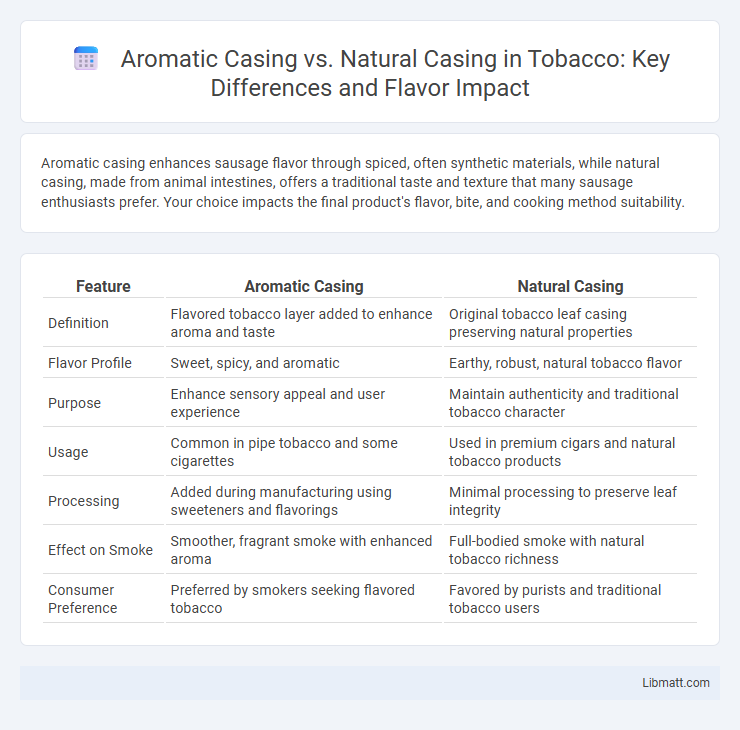Aromatic casing enhances sausage flavor through spiced, often synthetic materials, while natural casing, made from animal intestines, offers a traditional taste and texture that many sausage enthusiasts prefer. Your choice impacts the final product's flavor, bite, and cooking method suitability.
Table of Comparison
| Feature | Aromatic Casing | Natural Casing |
|---|---|---|
| Definition | Flavored tobacco layer added to enhance aroma and taste | Original tobacco leaf casing preserving natural properties |
| Flavor Profile | Sweet, spicy, and aromatic | Earthy, robust, natural tobacco flavor |
| Purpose | Enhance sensory appeal and user experience | Maintain authenticity and traditional tobacco character |
| Usage | Common in pipe tobacco and some cigarettes | Used in premium cigars and natural tobacco products |
| Processing | Added during manufacturing using sweeteners and flavorings | Minimal processing to preserve leaf integrity |
| Effect on Smoke | Smoother, fragrant smoke with enhanced aroma | Full-bodied smoke with natural tobacco richness |
| Consumer Preference | Preferred by smokers seeking flavored tobacco | Favored by purists and traditional tobacco users |
Introduction to Sausage Casings
Sausage casings play a crucial role in defining the texture and flavor profile of your sausages, with aromatic casings offering infused herbs and spices that enhance taste complexity. Natural casings, derived from animal intestines, provide a traditional, elastic casing that contributes to a snappy bite and authentic sausage experience. Choosing between aromatic and natural casings affects not only the flavor but also the cooking properties and final presentation of your sausages.
What is Aromatic Casing?
Aromatic casing is a type of sausage casing infused with natural or synthetic flavor compounds to enhance the aroma and taste of the sausage during cooking. Unlike natural casing, which is made from animal intestines and primarily serves as a protective wrapper, aromatic casing contributes actively to the flavor profile by releasing herbs, spices, or smoke essence. This specialized casing is popular in artisanal and gourmet sausage production for its ability to intensify sensory appeal without altering the meat blend.
What is Natural Casing?
Natural casing is derived from the cleaned intestines of animals such as pigs, sheep, or cows, used primarily in sausage making. These casings offer an authentic texture and flavor, allowing the sausage to breathe and retain moisture during cooking. Their biodegradable and edible properties make them a traditional and preferred choice for many artisanal sausage producers.
Production Methods of Aromatic Casings
Aromatic casings are produced through specialized processes involving smoking or soaking natural hog or collagen casings in a blend of aromatic compounds, such as spices and essential oils, to impart distinct flavors. These production methods enhance the casing's sensory attributes without compromising its structural integrity, ensuring an optimal balance between taste and texture in the finished sausage. Your choice of aromatic casing can significantly influence the overall flavor profile and consumer appeal of your sausage products.
Sources and Types of Natural Casings
Natural casings primarily originate from the intestines of animals such as pigs, sheep, and cattle, with hog casings being the most common for sausages. These casings are categorized into three main types: hog casings (small and medium diameter), sheep casings (smaller diameter suitable for cocktail sausages), and beef casings (larger diameter ideal for thicker sausages and salami). Natural casings offer unique permeability and elasticity, contributing to the authentic texture and flavor of traditional sausages.
Flavor Profiles: Aromatic vs Natural Casings
Aromatic casings enhance sausage flavor with added herbs and spices, creating a distinctive and intensified taste profile. Natural casings, derived from animal intestines, contribute a subtle, slightly earthy flavor that complements the meat's natural essence. This contrast makes aromatic casings ideal for bold, complex sausages, while natural casings suit traditional, authentic flavors.
Texture and Bite Comparison
Aromatic casings offer a tender yet firm texture, providing a consistent bite that enhances the overall eating experience without overwhelming a sausage's flavor profile. Natural casings, typically made from animal intestines, deliver a slightly chewier and more resilient bite, contributing to a traditional snap that many sausage enthusiasts prefer. The distinct texture differences between aromatic and natural casings influence mouthfeel, with aromatic casings being softer and natural casings offering a satisfying crispness.
Culinary Applications of Each Casing
Aromatic casing, infused with herbs and spices, enhances the flavor profile of sausages, making it ideal for gourmet and specialty dishes where seasoning depth is crucial. Natural casing, derived from animal intestines, offers a traditional texture and snap that is preferred in classic sausage recipes like bratwursts, hot dogs, and chorizos. Your choice between aromatic and natural casing directly impacts the culinary outcome, influencing both the taste complexity and the mouthfeel of the final product.
Health and Safety Considerations
Natural casings are derived from animal intestines and pose a higher risk of bacterial contamination if not properly processed, requiring strict hygiene standards to ensure safety. Aromatic casings, often made from synthetic or treated materials, offer improved control over foodborne pathogens and chemical exposure, enhancing consumer safety. Your choice between aromatic casing and natural casing should weigh the balance of traditional flavor profiles against modern health and safety protocols.
Consumer Preferences and Market Trends
Consumer preferences for aromatic casing often emphasize flavor-enhancing qualities and a distinctive taste profile, appealing to gourmet and specialty sausage markets. Natural casing remains favored for its traditional texture and authentic appearance, driving demand in artisanal and regional sausage products. Your choice between aromatic and natural casings can influence market positioning, reflecting trends toward either innovation or heritage in the sausage industry.
Aromatic casing vs Natural casing Infographic

 libmatt.com
libmatt.com